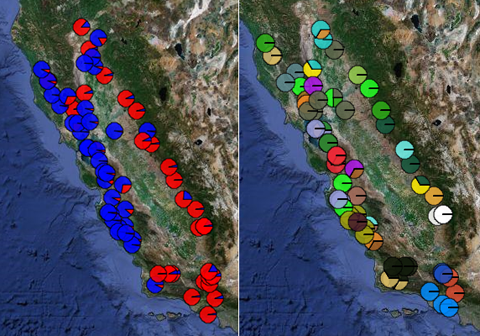Valley oak (Quercus lobata) is endemic to California and was one of the primary species in oak savanna and woodland ecosystems in and around the Central Valley before extensive agricultural clearing began in the late 1880s. It is now rare to see extensive groves of this species.
Our research group has studied geographic patterns of genetic variation in valley oak to see to infer the impacts of Quaternary glacial-interglacial cycles and to develop regional conservation priorities that take into account evolutionary history (Grivet et al. 2006, 2008), genetic diversity (Grivet et al. 2006, Sork et al. 2009), and future response to environmental change (Sork et al. 2010).
History of colonization
The use of maternally inherited molecular markers (chloroplast markers in the case of oak) allows us to reconstruct the history of seed dispersal and colonization.
We collected leaves from sites across California (Figure 1), and screened them with six chloroplast microsatellites. The results show a high number of haplotypes relative to European oaks, a low level of within-population diversity, and relatively high differentiation among populations (Figure 2, right) (Grivet et al. 2006, 2008). Despite strong genetic structure, analyses of genetic connectivity suggest long-distance colonization throughout the range (Figure 3) (Sork et al. 2010). Combined with geologic, climatic and pollen information, these genetic data suggest that through time oak populations locally contracted, expanded and recolonized landscape while maintaining their genetic diversity.
Ongoing research is combining chloroplast microsatellites, nuclear microsatellites (Figure 2, left), and ecological niche models to gain further insight into Quaternary population dynamics of valley oak (Gugger et al. in prep.).
| Figure 1. Location of 65 valley oak sample sites. |
|---|
 |
| Figure 2. (left) Map of valley oak genetic groupings based on nuclear microsatellite markers, using InStruct (K = 2). (right) Map of valley oak genetic groupings based on chloroplast microsatellite markers, using BAPS (K = 25). |
|---|
 |
| Figure 3. Analysis of population networks using chloroplast markers and illustrating connectivity through colonization by acorns among sites throughout valley oak range. Data were analyzed using Popgraph software of Rodney Dyer. |
|---|
 |
Geographical structure of nuclear genetic variation
We have studied geographic patterns of genetic variation in valley oak, Quercus lobata Née, to assess how underlying genetic structure of populations might influence this species’ ability to survive climate change. Using nuclear microsatellite markers, we examined the correlation between multivariate nuclear genetic variation and climatic variation. Using canonical trend analysis, we found that multivariate nuclear genotypes showed a strong association with climate variation (Figure 4). These data demonstrate that the geographical structure would allow strong opportunity for local adaptation to the conditions within their climatic envelope.
Climate change
Our genetic work illustrates that different regions of California are likely to be adapted to different climatic conditions (Sork et al. 2010). Our climate change modeling demonstrates that different regions will experience different future climatic conditions. If we model the future climate zones of different regions and compare it to that same climate zone based on 1971-2000 climate conditions, we see that the climate zone will shift varying distances in different parts of the range (Figure 5). For example, the climate zone for some of the eastern populations will be less than 10 km away, which might be within the range of pollen-mediated gene flow over the next 80 years, while the climate zone shifts more than 75 km in some of the western sites. This analysis suggests that valley oak is not vulnerable to climate change throughout its range. However, western populations may be most at risk for being out of sync with future climate conditions – a hypothesis that should be tested.
Resulting studies
Sork V. L., F. W. Davis, R. Westfall, A. Flint, M. Ikegami, H. F. Wang, and D. Grivet. 2010. Gene movement and genetic association with regional climate gradients in California valley oak (Quercus lobata Née) in the face of climate change. Molecular Ecology 19: 3806-3823.
Sork V. L., F. W. Davis, and D. Grivet. 2009. Incorporating genetic information into conservation planning for California valley oak. Pages 497-509 in Merenlender, Adina; McCreary, Douglas; Purcell, Kathryn L., tech. eds. Proceedings of the sixth California oak symposium: today’s challenges, tomorrow’s opportunities. Gen. Tech. Rep. PSW-GTR-217. Albany, CA: U.S. Department of Agriculture, Forest Service, Pacific Southwest Research Station.
Grivet, D., V. L. Sork, R. D. Westfall, and F. W. Davis. 2008. Conserving the evolutionary potential of California valley oak (Quercus lobata Née): a multivariate genetic approach to conservation planning. Molecular Ecology 17:139-156.
Grivet, D., M.-F. Deguilloux, R. J. Petit, and V. L. Sork. 2006. Contrasting inter-continental patterns of historical colonization in white oaks. Molecular Ecology 15: 4085-4093.


